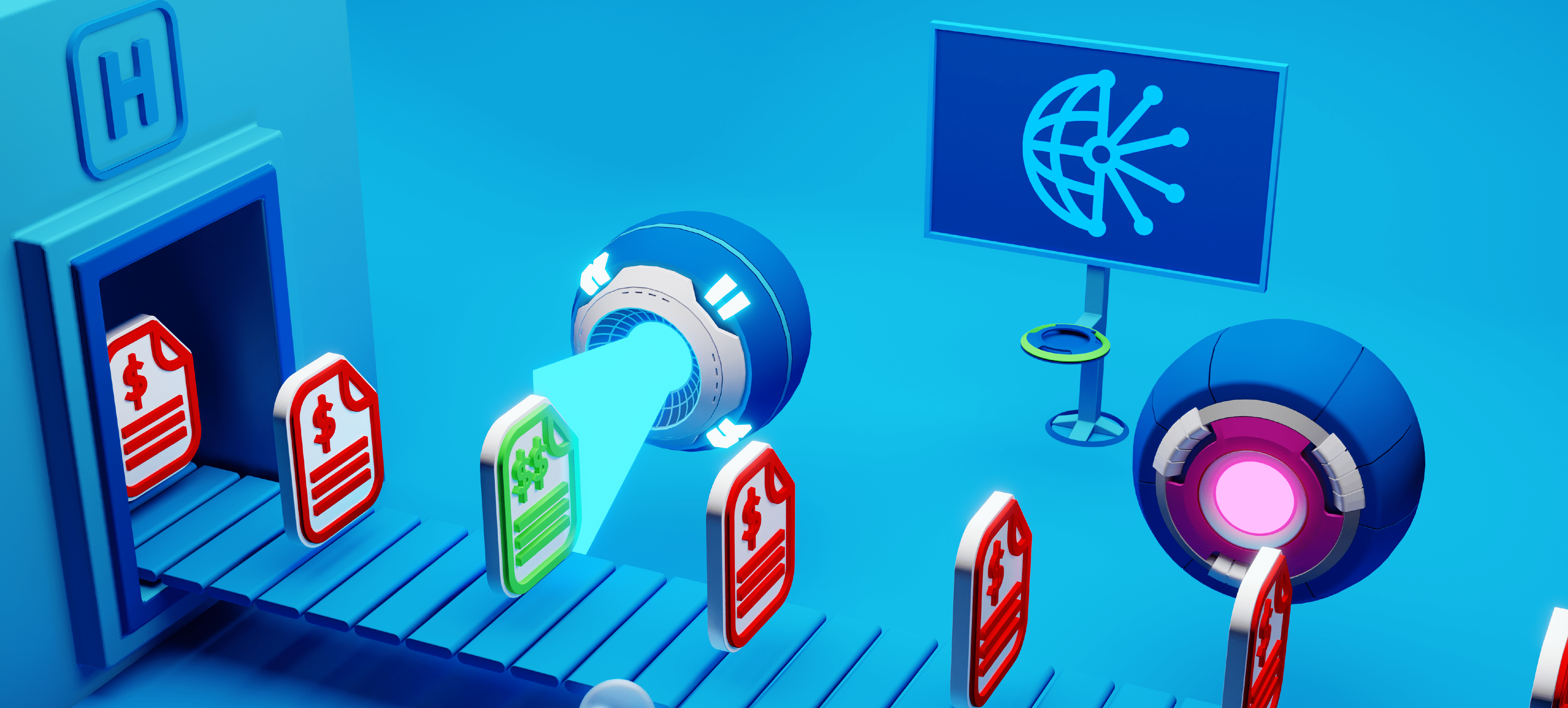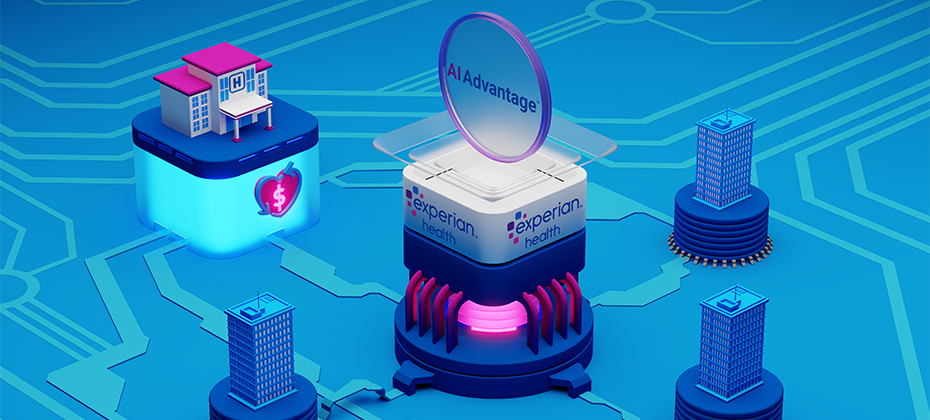Search Results for: artificial intelligence

With the ability to be applied across many different areas – from disease prediction to claims management and administrative tasks – data and analytics in healthcare is booming. In fact, according to a Grand View Research report, the global market for data analytics was valued in 2022 at $35 billion and is expected to increase at a compound annual growth rate of 21.4% until 2027. So, why the rapid growth? How can healthcare data analytics be used across the healthcare revenue cycle? The role of data and analytics in healthcare Historically, there has been a large amount of healthcare data being generated, but the industry has struggled to properly leverage this data into useful insights that improve patient outcomes, operations, or revenue. Today, with increasingly advanced data analytics, healthcare providers are using real-time data-driven forecasts to stay nimble and pivot quickly in rapidly changing healthcare and economic environments. And there is more data collaboration between healthcare organizations to convert analytics-ready data into business-ready information, thanks to the ability to automate low-impact data management tasks. Data-derived intelligence is also now easier to share with colleagues, third parties and the public. Types of healthcare data analytics methodologies and tools Healthcare data analytics involves several different types of methodologies and tools – all of which can be applied to various aspects of revenue cycle management. For example, descriptive analytics allows organizations to review data from the past to gain insights about previous trends or benchmarks. Predictive analytics, on the other hand, uses modeling and forecasting to help predict future results. When a strategic course of action is needed based on certain data inputs, prescriptive analytics is used. If a provider wants to take a deep dive into raw data to uncover patterns, outliers, and interconnection, they may employ discovery analytics. There are also generally three categories of technology-driven tools that can help collect and convert raw data into usable insights during the revenue cycle, including: Solutions that gather data from a wide variety of sources, such as patient case files, machine-to-machine data transfers, and patient surveys Programs designed to scrub, validate, and analyze data in response to a specific question being researched Software created to leverage the results produced by the analysis into actionable suggestions that be applied to meet specific goals Applying data analytics to maximize revenue “There are many things driving near-constant change in the healthcare revenue cycle, including shifting reimbursement, evolving value-based payment models, growing regulatory pressures, and increasing provider risk and patient responsibility,” says John Menard, VP of Product, Analytics, at Experian Health. “Healthcare organizations are also adapting to value versus volume reimbursement models, requiring revenue cycle leaders to lean into leveraging data analytics to improve not just operational efficiency, but patient financial experience and quality outcomes as well." Here's a closer look at how data analytics can help with revenue cycle management: Assessing patient finances From registration to collections, data analytics can play a key role at every step of the patient journey – and revenue cycle. Not only can the right data analytics tools help healthcare organizations better assess a patient's individual financial circumstances, but they can also help providers create accurate estimates and payment plan recommendations. Data-driven technology can help providers reduce surprise billing through more transparent pricing, helping patients navigate the cost of care and providing more timely patient communication. Digital solutions can help improve the patient financial journey by: Providing a self-service patient portal – With a solution like PatientSimple, patients get convenient 24/7 access to self-service account management tools. They can use the online portal to log into their healthcare account to securely process payments, request or review payment estimates, and schedule appointments. The portal also provides patient access to pricing information, plus the ability to apply for financial assistance or set up payment plans. With easy-to-use patient online tools, patients are more likely to meet their self-pay responsibilities and providers get paid more quickly as a result. Offering payment solutions – To collect payments with confidence, healthcare providers can utilize comprehensive data collection and advanced analytics through a digital solution like Patient Financial Clearance. With this solution, providers use a patient's financial data to quickly assess a patient's propensity and likelihood to pay prior to treatment. When appropriate, providers can then offer empathetic financial counseling and connect those that potentially qualify to financial assistance programs. By applying data analytics to this payment solution, healthcare organizations can increase point-of-service collections while reducing bad debt—in real-time. Providing patients with more accurate estimates – A recent Experian Health study found that 4 in 10 patients said they spent more on healthcare than they could afford. However, when patients know the expected cost of their care up front, they feel more empowered and make better decisions. Patient Estimates lets providers create more accurate estimates, eliminate manual tasks and improve patient satisfaction. Plus, it allows providers to automate and standardize their price transparency practices, which can help healthcare organizations meet regulatory requirements, create a more positive patient experience and increase revenue at the point of service. Reduce denied claims According to Experian Health's 2022 State of Claims survey, denied claims are on the rise with 42% of providers reporting that denials increased in the past year. 47% of respondents also said improving clean claims rates was a top pain point. Digital solutions can help providers reduce denied claims and increase revenue by: Automating claims management – With a solution like ClaimSource®, providers can automate their claims management systems – helping to ensure claims are clean before they are submitted to a government or commercial payer. Using an automated solution also allows providers to streamline the claims management process from a single web application. With ClaimSource, providers can easily analyze claims, payer compliance and insurance eligibility. Plus, it allows staff to prioritize their workload and focus on high-impact accounts – resulting in claims denial rates of just 4% compared to the industry average of more than 10%+. Optimizing efficiencies through artificial intelligence – Incorporating artificial intelligence (AI) into an automated claims management solution enhances the claims process in two key moments: before claim submission and after claim denial. AI Advantage™ integrates seamlessly with ClaimSource to continuously learn and adapt to ever-changing payer rules. The solution features two AI offerings, AI Advantage – Predictive Denials and Denial Triage, which can be customized to prioritization thresholds. Verify insurance and patient information Missing patient healthcare data can be a headache for providers to hunt down but looking for active coverage is often necessary. Providers must contend with a range of factors impacting patient coverage – including forgotten coverage, inadequate coverage, patients being misclassified as self-pay and regulatory changes, particularly with Medicaid and Medicare coverage. Implementing digital solutions can help providers use data to verify and find missing patient health insurance coverage, optimize patient collections, and boost revenue by: Utilizing automated, real-time insurance verification – Verifying patient coverage prior to service using a digital solution, such as Experian Health's Insurance Eligibility Verification. This tool can help providers experience fewer payment delays and claim denials. Plus, verifying insurance with automated insurance eligibility and benefits data improves cash flow, reduces claims denials and speeds up payments, including Medicare reimbursements. Patients also feel empowered with accurate payment estimates and accelerated registration, leading to a better patient experience overall. Improving collections with better data – With Collections Optimization Manager, providers can screen out bankruptcies, deceased accounts, Medicaid and other charity eligibility ahead of time. Through targeted collection strategies, providers can leverage actionable insights to focus on high-value accounts. Plus, predictive algorithms and data-driven rules help providers route and distribute accounts to the right collectors and agencies, controlling overall collection costs. This solution also connects providers to live support from an experienced optimization consultant that will help develop a tailored collection strategy through data evaluation and industry knowledge. Finding unidentified coverage – In 2022, Coverage Discovery tracked down previously unknown billable coverage in 28.1% of self-pay accounts, finding more than $64.6 billion in corresponding charges. Providers can use Experian Health's Coverage Discovery solution at any point in the revenue cycle to look for previously unidentified coverage – maximizing insurance reimbursement revenue and reducing accounts sent to collections, charity, or bad debt. Coverage Discovery also automates self-pay scrubbing and proactively identifies billable Medicare, Medicaid, and private insurance options, using a mix of search, historical information, proprietary data sources and demographic validation. See how the right data and analytics can help providers better understand their patients, streamline operations, and improve revenue.

Many hospitals and health systems are rethinking their responses to the growing challenge of healthcare claims management. After all, claims are becoming increasingly more complex. Payer policy edits are changing at a scale not seen before. And the legacy of the pandemic continues to take a toll on administrative workflows. In Experian Health's State of Claims survey 2022, providers reiterated the urgent need to optimize claims management – and the mountains of wasted dollars that are the by-product of preventable denials. Could artificial intelligence (AI) and machine learning (ML) be the key? What does the future of healthcare claims and AI look like? The internet is buzzing with excitement about the AI revolution, but the adoption of AI technology in healthcare has been slow, compared to other industries. Providers may be unclear about implementing AI effectively or struggle to see a route around barriers to adoption. This includes concerns around legacy systems and data interoperability. That said, the uptake of AI in healthcare shot up by 167% between 2019 and 2021, as organizations spotted opportunities to leverage new technology to reduce denials, optimize processes and identify patterns. Now, the AI genie is out of the bottle. As the trend continues to grow, providers that fail to embrace these technological advances risk falling behind as their competitors race forward. This article looks at AI's role in the future of healthcare claims management, and specifically, how it can help providers streamline claims processing, recoup more revenue and gain a competitive edge. The growing challenge of healthcare claims management In Experian Health's State of Claims Survey 2022, providers said reducing denials was their number one priority. It's clear to see why. There have been more than 100,000 payer policy changes between March 2020 and March 2022. Staffing shortages continue to put pressure on both front-and back-office teams. Increasing patient volumes and changes to insurance coverage means more claims to process – with more complexity to boot. Looking ahead, providers need to find more efficient ways to manage and utilize increasing volumes of claims data to alleviate staffing pressure, improve productivity and future-proof against unexpected events. Failure to do so could be an expensive mistake, especially when margins are already tight and the economic landscape remains shaky. Digital claims management: from process-automation to pattern-spotting The survey suggests providers are increasingly turning to automation to improve claims management, with 78% saying they were likely to replace their current solution to achieve lower denial rates in the coming year. Upgrading claims technology, automating the tracking of payer policy edits, and automating patient portal claims reviews were the top three strategies for reducing denials. Automation can generate years of ROI by executing repetitive and error-prone administrative tasks at speed and at scale. A few examples of automation in action are tools like: ClaimSource®, which manages the entire claims cycle, creating custom work queues and automating the claims process for greater efficiency and accuracy. Claim Scrubber, which automatically reviews every line of every claim to check for errors, so claims are clean the first time, prior to submission. Denials Workflow Manager uses automation to help providers eliminate manual processes, prevent errors and increase reimbursement. AI takes this a step further, by analyzing vast amounts of information to find patterns and make predictions that support better, faster decision-making. Clarissa Riggins, Chief Product Officer at Experian Health explains why providers should embrace AI in claims and denials management: "Claims submissions and managing claims after denial are highly manual processes – and they are both extremely error-prone. AI/ML can learn from the data patterns in your claims to provide insights on where your claims are being denied most frequently. These solutions can also provide decision support to staff to help them to prioritize the work within their current claims processes, to avoid unnecessary denials in the first place and then to optimize their work to ensure a cleaner claim rate." While many providers see the potential of AI to streamline claims operations, prevent denials and accelerate reimbursement, others are hesitant to invest or are stumped by logistical barriers. Legacy technology, data compatibility issues and staff skills gaps can all put the brakes on AI implementation. But the AI train is showing no signs of slowing, and providers that fail to jump aboard could get left behind. With the right tools and an experienced vendor, implementation can be simplified. AI Advantage™ – the engine for predictive denials and denials triage Experian Health's new AI-powered denials management solution uses a two-pronged approach to predict, prevent and prioritize denials. First, AI Advantage – Predictive Denials identifies claims that may be at risk of being denied, based on analysis of historical payment data and payer decisions. This gives staff time to intervene and make any necessary amendments before the claim is submitted. The second element, AI Advantage – Denial Triage, applies an algorithm to segment denials based on the likelihood of reimbursement. This means staff can focus on high-impact resubmissions, rather than simply prioritizing high-value claims that may or may not be paid. Rob Strucker, Product SVP at Experian Health, explains that AI Advantage™ is continuously learning in real-time, so that predictions are increasingly accurate: “We look at the provider's own information for this type of service for this payer, and how those claims have been adjudicated. From that, we can score each claim in terms of its probability of being denied or claimed, and then based on that probability score, trigger an appropriate alert.” How Schneck Medical Center optimized healthcare claims management with AI Advantage™ AI Advantage™ proved to be the solution Schneck Medical Center was looking for when they set out to reduce denials. Within six months, Experian Health's AI-powered solution enabled Schneck to reduce denials by an average of 4.6% each month. Staff reported that the probability thresholds calculated by AI Advantage™ were highly accurate, facilitating a more efficient approach to reworking claims. Processing time was cut from 12 to 15 minutes to less than 5 minutes per claim. Clarissa Riggins says that AI Advantage gives staff confidence that they're spending their time on the right tasks: "When you have an algorithm that can evaluate the probability that a denial will be overturned, you can make sure that staff are working on the claims with the most potential for yield. Taken together, these solutions can help ensure that hospitals and health systems are getting paid for the good work they do in delivering care." Thanks to the tool's predictive capabilities, staff now have the insights (uncovered from within their own data) to prevent denials before claims are submitted, and to speed up rework should any be denied. As claim denials continue to increase in number and complexity and healthcare costs continue to grow, providers are feeling the impact on their revenue and margins. AI can ease the pressure by optimizing the healthcare claims management process. Find out more about how AI Advantage™ can help providers improve healthcare claims management and prevent costly claim denials.

Could the era of manual claims processing be coming to an end? Experian Health's State of Claims 2022 survey revealed that more than half of healthcare providers have embraced advanced automation, freeing up staff from time-consuming and inefficient manual tasks. Automation has dominated as the key strategy used by providers to reduce denials in the previous 12 months. This evident optimism about technology's ability to address challenges in the claims process suggests that automation is here to stay. However, while automation has cracked open the doors to more efficient claims processing, the predictive power of artificial intelligence (AI) in claims processing can unlock exponentially higher rates of reimbursement. Providers may be increasingly aware of the benefits of automation, but many have yet to step into the world of AI. This article considers the advantages to be found in layering AI technology on top of automated claims processing and looks at how two new AI solutions are helping providers reduce denials and expedite payments. How automation helps with claims processing Healthcare organizations with automated claims processing report improvements in speed, accuracy, financial performance and patient experience. For example: Automated claims management solution ClaimSource® helped Hattiesburg Clinic in Mississippi accelerate cash flow, reduce denials to 6.1%, and expedite claims from secondary and tertiary payers. Summit Medical Group Oregon used Enhanced Claim Status and Claim Scrubber to reduce accounts receivable days by 15% and achieve a first-time pass-through rate of 92%. These tools improve efficiency across the entire claims cycle by automating repetitive tasks, executing effective workflows and generating data-driven insights into root causes of denials so staff can prioritize high-impact tasks and errors are far less likely. Industry reports corroborate these positive results: CAQH reports that the medical industry could save as much as $22.3 billion per year through further automation. Unlocking the untapped potential of AI in claims processing Despite automation's impressive results, claim denials remain a thorn in the side of many revenue cycle leaders. This is where AI can help, thanks to its ability to predict and respond to payer behavior and claims data. But while 51% of survey respondents were using automation, only 11% had introduced AI-based technology to their claims process. For the AI-curious, combining automation and AI could be a good starting point to supercharge claims processing. AI technology can predict potential issues before they even occur by analyzing claims and denials and making suggested corrections or interventions in real-time. It can also assist in identifying fraudulent claims and denials, leading to improved claims processing accuracy and revenue cycle management. By using automation and AI together, healthcare providers can gain better insights into their claims and denial data, resulting in improved financial performance and greater efficiency. What does that look like in practice? More efficient and accurate claims predictions Automation can relieve staff of manual data handling activities, increasing the speed and accuracy of claim processing, from patient intake through scrubbing, submission and adjudication. AI enables staff to perform remaining tasks with greater confidence and accuracy. They no longer need to wonder, “which claim should I rework first?” – AI has the answer. Without AI, the logical approach would be to rework what appear to be the highest-value denials first. But in many cases, these aren't the ones most likely to result in reimbursement. AI can help staff prioritize by analyzing historical payment data and undocumented payer adjudication rules to flag denials that are most likely to be paid. This is exactly how AI Advantage™ – Predictive Denials works. Experian Health's new AI-based solution checks for any changes to the way payers handle denials and assesses these against previous payment behavior. Providers can set their own threshold for the probability of denial, and if the solution determines that a claim will exceed this threshold, it alerts staff so they can act quickly and decisively before the claim is submitted. Schneck Medical Center was an early adopter of this tool and used it to complement their existing claims workflow (built around ClaimSource®). Within six months, they saw average monthly denials drop by 4.6%. Predictive alerts allowed staff to focus efforts on submitting clean claims the first time, so both the number of denials and hours spent reworking them were drastically reduced. “Learning” from denials data to drive financial performance By definition, automated claims processing systems will repeat the same tasks over and over. This is great for operational efficiency but has limited capacity to handle variation. A major advantage of an AI-based solution is its capacity to “learn” and predict, so each claim can be individually assessed and directed to the most appropriate workflow. AI Advantage™ – Denial Triage uses advanced algorithms to identify and intelligently segment denials so that providers can prioritize accordingly. Just as Predictive Denials uses historical payment data to predict the claims that may be at risk of rejection, Denial Triage learns from payers' past decisions to predict the denials that are most likely to be reimbursed if reworked. Read more about Schneck Medical Center's experience with AI Advantage. How does using AI benefit healthcare staff? The use of AI in claims management can be met with different reactions: some staff are enthusiastic about the prospect of having manual tasks taken off their plate and being able to use their time more effectively. Others may be concerned about the impact of AI on jobs and recruitment. The reality is that many providers face ongoing staffing shortages, and therefore have little option but to augment their existing teams with new technology. Maintaining pre-pandemic headcounts in light of post-pandemic work patterns and budgets may not be possible. Automation and AI can resolve these short-term challenges while generating a positive ROI in the long term, as the volume and complexity of claim denials continue to grow. As noted in the State of Claims 2022 report, technology should no longer be viewed as a threat to jobs, but as a way of making life easier for staff. Automation and AI work hand in hand to execute tasks that many staff find time-consuming and laborious, leaving the more stimulating and high-value tasks for the human workforce. Improving operational performance can therefore have a positive effect on job satisfaction and retention. The integration of AI in claims processing is not about replacing human expertise, but about harnessing the power of AI-powered algorithms to enhance efficiency and minimize denials. The optimal approach lies in combining the strengths of automation, AI and staff. Automation handles repetitive processes, AI expedites decision-making, and human expertise brings contextual understanding and empathy to the process. Learn more about how Experian Health can help organizations utilize AI in healthcare claims processing with AI Advantage.

Artificial intelligence (AI) is changing the healthcare industry. From disease detection to chatbots, AI is having a significant impact on the way healthcare providers operate and deliver care to patients. Additionally, AI is transforming the revenue cycle management process by automating tasks, such as claim denials management. By leveraging AI tools, healthcare providers can reduce the time and resources required for manual claims processing, ensuring that claims are paid faster and with greater accuracy. As claim denials continue to rise by 10-15%, healthcare organizations continue to grapple with the adverse effects on their finances. That's why Experian Health created AI Advantage™ – an innovative solution that helps providers with better claim denial management. The first component, AI Advantage – Predictive Denials, proactively identifies claims that are at high risk of being denied, so providers can edit the claim prior to submission. The second component, AI Advantage – Denial Triage, steps in after claims have been denied to identify those with the highest potential for reimbursement. Schneck Medical Center is one example of a healthcare organization that has seen significant results from implementing AI Advantage. After just six months, they successfully reduced denials by an average of 4.6% each month. Corrections that would previously have taken their organization 12 to 15 minutes to rework could now be processed in under 5 minutes. With AI Advantage, healthcare organizations can improve their claim denials management processes, increase efficiency, and reduce administrative costs. The solution's ability to prevent and reduce claim denials in real time can help healthcare providers maximize revenue while delivering high-quality patient care. As healthcare organizations continue to face mounting financial pressures and staffing shortages, AI-powered solutions will be increasingly important in helping them navigate these challenges and achieve long-term success. Learn more about how healthcare organizations can begin their journey towards improving efficiency and reducing claim denials with AI Advantage.

“The challenge we sought to overcome by leveraging AI Advantage at our organization was just gaining more insight into how denials originate and what actions we can take to prevent those from happening.” — Skylar Earley, Director of Patient Financial Services, Schneck Medical Center Challenge Starting as a 17-bed hospital more than 100 years ago, Schneck Medical Center now serves four counties in Indiana, with a staff of more than 1,000 employees, 125 volunteers and nearly 200 physicians. The organization’s vision is to deliver excellence, lead transformation and advance health, underpinned by a patient-first philosophy. For the Patient Financial Services team at Schneck Medical Center, reworking denied healthcare claims was often time-consuming and inefficient. Billers tended to prioritize high-value claims, without knowing the probability of reimbursement. They sought a denial management solution that would reduce the risk of denied claims and minimize their impact on the revenue cycle. Solution Schneck worked with Experian Health to test two new denial management solutions that use artificial intelligence (AI) to reduce the likelihood of denials and prioritize rework to maximize reimbursement. The first, AI Advantage™ – Predictive Denials, uses AI to predict claims that have a high chance of being denied, so they can be corrected before the claim is sent to the payer. If a claim review exceeds the suggested threshold for denial probability, an alert is triggered, and the flagged claim is automatically routed to the appropriate biller. The biller investigates the alert to understand what changes are needed. This might include checking insurance eligibility, reviewing coding errors or reviewing authorization status. Once the alert is resolved, the claim can be automatically resubmitted. The second solution, AI Advantage™ – Denial Triage, prioritizes denials based on the potential for reimbursement so staff can focus recovery efforts on the right claims. The triage process starts with identifying between 2 and 10 denial segmentation categories based on likelihood of reimbursement. Schneck chose to identify 5 categories to start. Individual remits are evaluated and automatically assigned to the appropriate category, so they can be routed to the correct specialist. The tools use historical claims data and a continuously learning AI model to detect patterns in payer decisions. Staff can customize denial probability thresholds and segmentation criteria to ensure claims are routed to the correct specialist. The solutions integrate seamlessly with Schneck’s existing claims management system, ClaimSource®, and other health information workflows. Outcome After just six months, AI Advantage helped Schneck reduce denials by an average of 4.6% each month. Corrections that would previously have taken 12 to 15 minutes to rework can now be processed in under 5 minutes. Staff report that the thresholds determined by AI Advantage – Predictive Denials are highly accurate, leading to better decision-making when reworking claims prior to submission. And with AI Advantage – Denials Triage, staff feel confident that they’re focusing their attention on the right segments, rather than wasting time on high-value claims that are unlikely to be reimbursed. Skylar Earley says, “Before, we had no insight into whether we were performing value-added work when we followed up and worked denials. Now we see those percentages.” Learn more about how AI Advantage generates insights to help healthcare organizations reduce time spent working denials and maximize reimbursement.

Healthcare is undergoing a digital revolution driven by artificial intelligence (AI) and machine learning (ML) technology. While some organizations have been slow to adapt, others incorporated new solutions that have helped their organization identify patterns, reduce claim denials, and more. This infographic breaks down common phrases related to artificial intelligence and machine learning so that healthcare organizations can understand what they mean and how they're utilized. Introducing: AI Advantage™ Experian Health is the top-performing claims management vendor, according to the 2023 Best in KLAS: Software and Professional Services report. Experian Health’s ClaimSource® solution, an automated, scalable claims management system designed to prevent claim denials, ranked number one in the Claims Management and Clearinghouse category. With denials and staffing shortages on the rise, an efficient claims management strategy is essential. Experian Health is here to help with AI Advantage™ – a new solution that utilizes true artificial intelligence that proactively helps reduce denials and, when necessary, identifies the best denials to resubmit.

In 2009, processing claims was listed as the second greatest contributor to “wasted” healthcare dollars in the US, at an estimated $210 billion. A decade later, that amount was estimated at $265 billion. Today, healthcare providers are still grappling with denied healthcare claims, with both challenges and solutions accelerated by the pandemic. To put the scale of operational and delivery changes into perspective, Experian Health recorded well over 100,000 payer policy changes for coding and reimbursement between March 2020 and March 2022. The implications for claims processing are immense, which is why healthcare providers need to reevaluate their denial management strategies and invest in new technology that can help increase reimbursements. In June 2022, Experian Health surveyed 200 revenue cycle decision-makers to understand how they feel about the current situation. What are the priorities of those on the front line of denials management? And how can technology contribute to improvements? This article breaks down the key findings. Takeaway 1: Denials are increasing and reducing them is priority #1 30% of respondents say denials are increasing by 10-15% Nearly 3 out of 4 respondents say that reducing denials is their top priority For most respondents, claims management is more important now than it was before the pandemic, because of payer policy changes, reimbursement delays and increasing denials. Respondents attribute this to insufficient data analytics, lack of automation in the claims/denials process and lack of thorough staff training. When it comes to improving denial rates, staffing seems to be the greatest challenge. More than half of respondents say staff shortages are slowing down claims submissions and hampering efficiency. Shrinking offices mean there is less staff to handle the growing volume and complexity of claims. It’s no surprise, then, that around 4 in 10 respondents are also concerned about keeping up with rapidly changing payer policies and keeping track of pre-authorization requirements. Providers recognize that technology can help reduce denials while easing the burden on staff. A tool like ClaimSource manages the entire claims cycle using customizable work queues that make it easy to prioritize accounts, saving staff time and avoiding the errors that lead to denials. This also incorporates payer edits to ensure that claims are clean before being submitted to the payer. And if claims do end up needing further attention, Denials Workflow Manager eliminates time-consuming manual processes and allows providers to attend to high-risk claims quickly, so there’s less chance of delayed reimbursement. Takeaway 2: Automating denials management in healthcare is critical 52% of respondents upgraded or replaced previous claims process technology in the last 12 months 51% are using robotic processes, including automation, but only 11% are using artificial intelligence Prior to the pandemic, automation was sometimes perceived as a threat to jobs. But with changing employment patterns and evidence of the broader benefits of automation, attitudes are shifting. Automation can make life easier for staff by removing manual tasks to allow them to focus on other priorities. It speeds up the healthcare claims processing workflow, reduces the risk of errors, and enables better communication between providers, patients and payers. Providers recognize that automation drives more efficient claims management. The survey revealed that 45% of respondents turned to automation to keep track of payer policy changes, 44% had automated patient portal claims reviews, and 39% had digitized patient registration in the last year. Automation supports all stages of the claims management process, from auto-filling patient data during registration, to generating real-time claim status reports for back-office staff. Payer authorizations were a common challenge for providers, and a perfect fit for automation. Experian Health’s Prior Authorizations solution eliminates the need for staff to visit multiple payer websites, automates inquiries, and offers real-time updates on pending and denied submissions so staff knows when to intervene. Takeaway 3: Providers are searching for denial management solutions that will achieve the greatest ROI 91% of those likely to invest in claims technology say they will replace existing solutions if presented with a compelling ROI The majority of providers may be on the lookout for better claims management solutions, but they vary in how they measure ROI. Predictably, one of the most common metrics is how much staff time can be saved, with 61% concerned with hours spent appealing or resubmitting claims, and 52% looking at time spent reworking claims versus reimbursement totals. Rates of clean claims and denials were also popular metrics, at 47% and 41%, respectively. Using Denials Workflow Manager and ClaimSource alongside additional claims management solutions like Claim Scrubber and Enhanced Claim Status can deliver an even stronger performance against the above metrics. Each solves a specific challenge within the claims management workflow, but when used together, the ROI is multiplied. Overall, there’s optimism that digital technology and automation can help healthcare providers improve claims and denial management and reduce the amount of “wasted” dollars. This survey shows that providers are keen to grasp the opportunities offered by automation to optimize the reimbursement process and get paid sooner. Download the report to get the full results on the State of Claims 2022, and discover how Experian Health can help organizations with their denial management strategies.

The U.S. is currently struggling with a critical healthcare labor shortage that is impacting every part of the revenue cycle. In fact, the American Hospital Association has deemed this challenge a “national emergency” that is only expected to worsen. Staffing shortages leave healthcare providers vulnerable to reimbursement delays, low morale and negative patient experiences. As a result, many healthcare providers are leveraging automation to tackle this staffing crisis. Revenue cycle management (RCM) software and analytics can help providers navigate labor shortages by relieving staff of repetitive, process-driven manual tasks and improving operational efficiency. As healthcare labor shortages continue, how can providers maximize the return on their investment in automation? The snowball effect of healthcare labor shortages The first quarter of 2022 ended with a peak of 11.9 million open vacancies in the United States. Just about every industry is feeling the impact of the Great Resignation, driven largely by the fact that more people are reaching retirement age than are entering the labor market. In healthcare, the challenge of attracting and retaining top talent is felt even more acutely - in May 2022, the healthcare vacancy rate was 8.8%, second only to hospitality services. While the pandemic created greater pressures on healthcare staff, chronic understaffing and burnout were already a problem. Now, healthcare workers are contending with the snowball effect of increasing stress, sickness absences, lack of time to train new staff and loss of morale. Potential recruits may be tempted away to industries touting fewer COVID regulations, competitive pay, and more flexible and remote positions. Healthcare providers need smart and creative staffing strategies to close the gaps. Automation should be at the heart of HR contingency planning Providers may look to traditional market forces to solve the staffing challenge. Reducing services, increasing wages, improving working conditions and partnering with local education facilities to attract new staff are all on the table. But tight margins and inflationary pressures limit the options available, and policy changes can take time to be implemented. Automation can help mitigate healthcare labor shortages in three main ways. It can reduce the workload and increase staff capacity, improve operational performance and free up resources that can be reinvested in the workforce, and create better experiences for staff (and patients). Using automation to increase staff capacity Repetitive tasks that follow the same process every time are perfect for automated programs. Shifting the load from staff to software means that fewer team members are needed for those activities, and available staff can focus on more complex issues. Patient access is a good place to start. Many hospitals have already started to scale back care due to severe staffing shortages. Online scheduling and automated registration can ease the burden as patient volumes increase. These self-service tools cut down call center queues and eliminate labor-intensive data entry. With automated pre-registration, the correct information for each patient can be pre-filled and follow them throughout their healthcare journey, so staff no longer lose entire days spent resolving data input errors. Automation can improve operational efficiency, even with labor shortages Automation is more than replacing human effort with software programs: it also strengthens operational performance. Automated revenue cycle tools can complete tasks such as data entry, coverage checks, pre-authorizations and eligibility verifications much faster – and with fewer errors – than staff. If data-driven tasks can be completed with greater accuracy and efficiency, then the entire revenue cycle will move more quickly, leading to faster reimbursement. This is especially obvious when using automation to streamline collections. It doesn’t make sense for staff to pursue all past-due accounts, but with automation and advanced analytics, they can identify the patients most likely to pay and focus their efforts accordingly. Collections Optimization Manager uses multiple data sources to automatically screen and segment accounts, so staff doesn’t waste time chasing the wrong ones. Accounts are then distributed to appropriate collections channels using specific routing and recall rules. With a better understanding of each patient’s financial situation, staff can engage with patients in a more compassionate way and resolve issues without repeated calls and emails. Alongside this, automated patient outreach can provide personalized and convenient communications about patient collections. PatientDial frees up staff from time-consuming calls by providing automated inbound, outbound and blended calls with live agents or automated interactive voice response (IVR) services. “Queue callback” automatically calls patients back when a suitable agent becomes available, maximizing staff time while improving the patient experience. PatientDial also monitors agent performance so managers can make strategic decisions to improve workflow. Using automation to create better user experiences Existing staff may worry that increasing the use of automation could lead to their jobs becoming redundant. This isn’t really the case: while automation and artificial intelligence (AI) allow RCM teams to “do more with less” and reduce the need to recruit additional staff, they should be seen as complementary to rather than replacing staff. By removing time-consuming and tedious tasks, automation creates a better experience for staff. User-friendly interfaces give patient access, claims and billing teams all the information they need to help patients quickly and accurately. And as prior authorizations and payer policy changes change ever more frequently, staff will be relieved to hand over the task of checking each payer’s website to a software program that can complete the job quickly and accurately. Shifting to online and mobile options gives patients a more convenient and satisfying user experience, too. For example, automated self-service tools can be used to give patients upfront estimates about their expected cost of care, and link to convenient payment methods. It’s a quick win for providers who will find it easier to comply with new price transparency rules and makes it easier for patients to clear their bills faster. And the result? A happier workforce, a better patient experience and a healthier revenue cycle. Find out more about how Experian Health’s automated revenue cycle management solutions can help healthcare organizations build resilience and thrive in the face of healthcare labor shortages.

Being able to settle bills anytime, anywhere, is one of the reasons why 110 million Americans switched to “digital-first” payment methods last year. Today’s consumers can pay household bills with their mobile devices while cooking dinner or waiting in the school pick-up line. They can pay for their morning coffee by tapping their phone at the point of sale. Imagine their frustration when paying for healthcare still involves paper bills, multiple phone calls, and limited payment options. But the healthcare industry can make the same “anytime, anywhere” payment promise. Berenice Navarrete, Director of Product Management for Patient Payments at Experian Health, says: “We’ve seen healthcare make great strides in using automation and digital tools for scheduling, registration, and telehealth, fueled in no small part by the pandemic. As consumer payments are constantly evolving, there are huge opportunities for improvements in the patient payment experience too.” “We’ve seen healthcare make great strides in using automation and digital tools for scheduling, registration, and telehealth, fueled in no small part by the pandemic. As consumer payments are constantly evolving, there are huge opportunities for improvements in the patient payment experience too.” -Berenice Navarrete, Director of Product Management for Patient Payments Experian Health’s recent Payments Predictions white paper identifies seven emerging healthcare payment predictions and trends heading into 2022. This blog offers a preview of the top three insights that will be of interest to providers intending to leverage – or considering – digital tools that simplify payments and speed up healthcare collections. Prediction: Patients want fast, secure and smooth payments to match their experience in other industries. According to Experian Health’s State of Patient Access 2.0 survey, providers are feeling more confident about collecting payments from patients now, compared to a year ago. However, the collections landscape is always changing; providers should continue to find ways to match consumer expectations with tailored communications, flexible payment options and automated payment methods. Listen in as Matt Baltzer, Senior Director of Product Management at Experian Health, explains why providers feel more confident about patient collections. He also discusses how automated healthcare solutions can help providers shore up these gains and optimize healthcare collections – especially as consumer behavior returns to pre-pandemic patterns. As cash usage declines, patients are looking for a wider variety of payment options – a trend that’s likely to gather steam as digital payment platforms like Apple Pay and Google Pay continue to gain traction. Providers must keep pace with these advances in consumer payment technology. Utilizing Patient Financial Advisor is one way to give patients the flexible experience they want. This solution sends personalized text messages with links to convenient and contactless ways to pay. Patients may have different preferences about payment methods, but they all want to feel confident that their payment is secure. With PaymentSafe, healthcare providers can collect any form of payment securely and quickly, regardless of the payment option a patient chooses. Prediction: Patient loyalty will be tied to a convenient and compassionate payment experience. A poor payment experience will leave a bad taste in the patient’s mouth, regardless of how good the rest of their healthcare journey has been. With 70% of consumers saying healthcare is the industry that makes it hardest to pay, any provider that offers a smooth, supportive and transparent payment experience is going to stand out from the competition and foster greater patient loyalty. Comprehensive consumer data can give providers early and accurate insights into a patient’s specific financial situation. This information can help providers direct the patient to the most appropriate financing options. Automation can then be leveraged to send timely reminders of open balances, improve patient engagement and minimize the risk of missed payments. Tools such as Patient Financial Advisor and Patient Payment Estimates can help providers give patients transparency, control and reassurance from the very start of their financial journey, so bills are settled quickly and easily. Prediction: Automation will be used for an increasing number of payment-related tasks. Artificial intelligence and automation aren’t just for cars and the metaverse. Technological advancements are opening up a wide range of benefits to healthcare providers, from faster patient payments to fraud prevention. Automation also enables operational efficiencies in reporting and reconciliation, while protecting and processing unprecedented amounts of patient data. For example, Collections Optimization Manager uses extensive datasets and advanced analytics to segment patient accounts according to each individual’s specific financial situation. Patient satisfaction will improve because patients receive the right support at the right time. Additionally, providers will be able to use monitoring and benchmarking data to spot previously unseen opportunities and further improve collections. Keeping that “anytime, anywhere” promise COVID-19 was a catalyst for the evolution of healthcare payments. Digital payment solutions that give patients easy, convenient, and safe ways to pay not only help meet changing consumer expectations but will also allow providers to boost loyalty and revenue for years to come. Download the white paper to discover a full list of healthcare payment predictions and find out how to create a modern payment experience that meets patient expectations.